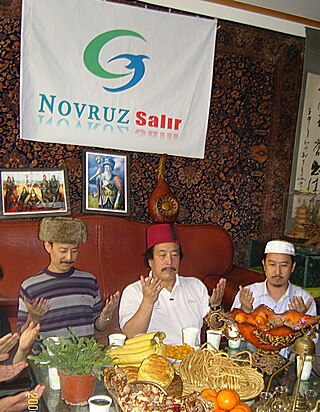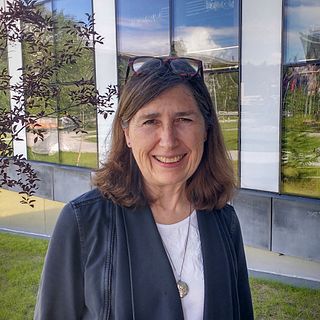
Arienne Dwyer is an American linguist, anthropologist and educator.

Arienne Dwyer is an American linguist, anthropologist and educator.
| | This section needs expansion. You can help by adding to it. (January 2025) |
Arienne Dwyer is the daughter of flutist Doriot Anthony Dwyer and a descendant of women's rights activist Susan B. Anthony.
She earned her PhD in 1996 in Altaic and Chinese Linguistics at the University of Washington. [1] She was a Humboldt postdoctoral research fellow and Volkswagen-DOBES grantee at the Johannes Gutenberg-Universität Mainz.
Dwyer has been a professor of Linguistic Anthropology in the Department of Anthropology at the University of Kansas since 2001. [2] She is also an affiliate Professor of Linguistics at the University of Washington. In 2010 she co-founded KU's Institute for Digital Research in the Humanities, [3] and co-directed it until 2018.
Dwyer conducts research into the languages and cultures of Inner and Central Asia, especially languages in the Turkic, Sinitic, and Mongolic families. She has also published pedagogical and linguistic materials for the Uyghur language. [4]
Her research is notable in arguing for the areal significance of Chinese Inner Asia as a Sprachbund, a region of language convergence. Her research also looks at issues of language documentation, Open Access and language ideology. [5] In 2014, her work led to her being named a Fellow of the John Simon Guggenheim Memorial Foundation. [6] [7]
Dwyer received NSF funding for and directed Institute on Collaborative Language Research (CoLang 2012), inviting Carlos Nash to be co-director. [8] [9] CoLang is an international training workshop in in situ language documentation supported by the National Science Foundation, convening in even years. [10]
Since 2010, her collaborative work has focused on sharing analyzed language resources, including a pilot website Interactive Inner Asia, [11] which provided some samples of language materials based on Dwyer's VW-DOBES project, and the Uyghur 2.0 website, [12] which includes the Uyghur Light Verbs project (on the diachrony of modern Uyghur complex predicates), and the Analyzing Turki Manuscripts Online (ATMO) project (creating digital editions of late eastern Chaghatay/early modern Uyghur language texts, with a focus on cultural and linguistic analysis of medical manuscripts, and social network analysis).

The Turkic languages are a language family of more than 35 documented languages, spoken by the Turkic peoples of Eurasia from Eastern Europe and Southern Europe to Central Asia, East Asia, North Asia (Siberia), and West Asia. The Turkic languages originated in a region of East Asia spanning from Mongolia to Northwest China, where Proto-Turkic is thought to have been spoken, from where they expanded to Central Asia and farther west during the first millennium. They are characterized as a dialect continuum.

The Uyghurs, alternatively spelled Uighurs, Uygurs or Uigurs, are a Turkic ethnic group originating from and culturally affiliated with the general region of Central Asia and East Asia. The Uyghurs are recognized as the titular nationality of the Xinjiang Uyghur Autonomous Region in Northwest China. They are one of China's 55 officially recognized ethnic minorities.

The Turkic peoples are a collection of diverse ethnic groups of West, Central, East, and North Asia as well as parts of Europe, who speak Turkic languages.

Chagatai, also known as Turki, Eastern Turkic, or Chagatai Turkic, is an extinct Turkic language that was once widely spoken across Central Asia. It remained the shared literary language in the region until the early 20th century. It was used across a wide geographic area including western or Russian Turkestan, Eastern Turkestan, Crimea, the Volga region, etc. Chagatai is the ancestor of the Uzbek and Uyghur languages. Turkmen, which is not within the Karluk branch but in the Oghuz branch of Turkic languages, was nonetheless heavily influenced by Chagatai for centuries.

The Oghuz Turks were a western Turkic people who spoke the Oghuz branch of the Turkic language family. In the 8th century, they formed a tribal confederation conventionally named the Oghuz Yabgu State in Central Asia. Today, much of the populations of Turkey, Azerbaijan and Turkmenistan are descendants of Oghuz Turks. The term Oghuz was gradually supplanted by the terms Turkmen and Turcoman by 13th century.

The Salar people are a Turkic ethnic minority in China who speak Salar, a Turkic language of the Oghuz sub-branch. They numbered 165,159 people in 2020, according to that year's national census.

Uyghur or Uighur is a Turkic language written in a Uyghur Perso-Arabic script with 8–13 million speakers, spoken primarily by the Uyghur people in the Xinjiang Uyghur Autonomous Region of Western China. Apart from Xinjiang, significant communities of Uyghur speakers are also located in Kazakhstan, Kyrgyzstan, and Uzbekistan, and various other countries have Uyghur-speaking expatriate communities. Uyghur is an official language of the Xinjiang Uyghur Autonomous Region; it is widely used in both social and official spheres, as well as in print, television, and radio. Other ethnic minorities in Xinjiang also use Uyghur as a common language.

Äynu is an Turkic cryptolect with a largely Iranic vocabulary spoken in Western China. It is spoken by the Äynu, a nomadic people, who use it to keep their communications secret from outsiders.

Old Siberian Turkic, generally known as East Old Turkic and often shortened to Old Turkic, was a Siberian Turkic language spoken around East Turkistan and Mongolia. It was first discovered in inscriptions originating from the Second Turkic Khaganate, and later the Uyghur Khaganate, making it the earliest attested Common Turkic language. In terms of the datability of extant written sources, the period of Old Turkic can be dated from slightly before 720 AD to the Mongol invasions of the 13th century.

Mahmud ibn Husayn ibn Muhammad al-Kashgari was an 11th-century Kara-Khanid scholar and lexicographer of the Turkic languages from Kashgar.

Salar is a Turkic language spoken by the Salar people, who mainly live in the provinces of Qinghai and Gansu in China; some also live in Ili, Xinjiang. It is a primary branch and an eastern outlier of the Oghuz branch of Turkic, the other Oghuz languages being spoken mostly in West and Central Asia. The Salar number about 105,000 people, about 70,000 (2002) speak the Salar language; under 20,000 are monolinguals.

Patricia Alice Shaw is a Canadian linguist specializing in phonology and known for her work on First Nations languages.
Language documentation is a subfield of linguistics which aims to describe the grammar and use of human languages. It aims to provide a comprehensive record of the linguistic practices characteristic of a given speech community. Language documentation seeks to create as thorough a record as possible of the speech community for both posterity and language revitalization. This record can be public or private depending on the needs of the community and the purpose of the documentation. In practice, language documentation can range from solo linguistic anthropological fieldwork to the creation of vast online archives that contain dozens of different languages, such as FirstVoices or OLAC.
The Turkic migrations were the spread of Turkic tribes and Turkic languages across Eurasia between the 4th and 11th centuries. In the 6th century, the Göktürks overthrew the Rouran Khaganate in what is now Mongolia and expanded in all directions, spreading Turkic culture throughout the Eurasian steppes. Although Göktürk empires came to an end in the 8th century, they were succeeded by numerous Turkic empires such as the Uyghur Khaganate, Kara-Khanid Khanate, Khazars, and the Cumans. Some Turks eventually settled down into sedentary societies such as the Qocho and Ganzhou Uyghurs. The Seljuq dynasty invaded Anatolia starting in the 11th century, resulting in permanent Turkic settlement and presence there. Modern nations with large Turkic populations include Kyrgyzstan, Turkmenistan, Turkey, Azerbaijan, Uzbekistan and Kazakhstan, and Turkic populations also exist within other nations, such as Chuvashia, Bashkortostan, Tatarstan and the Sakha Republic of Siberia in Russia, Northern Cyprus, the Crimean Tatars, the Kazakhs in Mongolia, the Uyghurs in China, and the Azeris in Iran.
Old Uyghur is a Turkic language which was spoken in Qocho from the 9th–14th centuries as well as in Gansu.
Sergey Yefimovich Malov was a Russian and Soviet Turkologist who made important contributions to the documentation of archaic and contemporary Turkic languages, classification of the Turkic alphabets, and the deciphering of the Turkic Orkhon script.
The Yenisei Kyrgyz were an ancient Turkic-speaking people who dwelled along the upper Yenisei River in the southern portion of the Minusinsk Depression from the 3rd century BCE to the 13th century CE. The heart of their homeland was the forested Tannu-Ola mountain range, in modern-day Tuva, just north of Mongolia. The Sayan Mountains were also included in their territory at different times. The Yenisei Kyrgyz Khaganate existed from 538 to 1219 CE; in 840, it took over the leadership of the Turkic Khaganate from the Uyghurs, expanding the state from the Yenisei territories into Central Asia and the Tarim Basin.
The Institute on Collaborative Language Research or CoLang is a biennial training institute in language documentation for any person interested in community-based, collaborative language work. CoLang has been described as part of a modern collaborative model in community-based methodologies of language revitalization and documentation.
The Fuyu Kyrgyz are a Turkic ethnic group who reside in Heilongjiang, China. They primarily reside in the Fuyu County. Their ethnic ties with the Kyrgyz/Kirghiz are unclear.
The Qinghai–Gansu sprachbund or Amdo sprachbund is a sprachbund in the plateau traversed by the upper Yellow River, including northeastern Qinghai and southern Gansu. This has long been an area of interaction between speakers of northwestern varieties of Mandarin Chinese, Amdo Tibetan and Mongolic and Turkic languages. These families feature contrasting typologies, which spread between languages in the region. The languages have come to share many features, and differ significantly from their relatives outside the region.